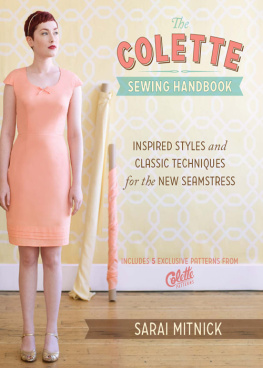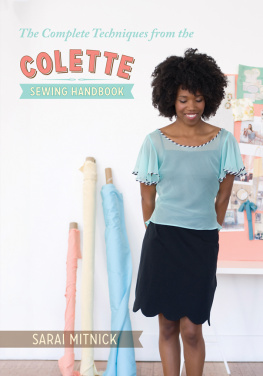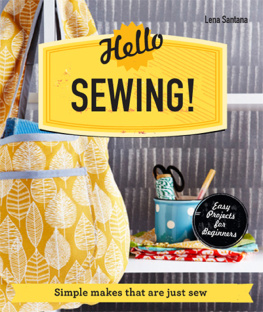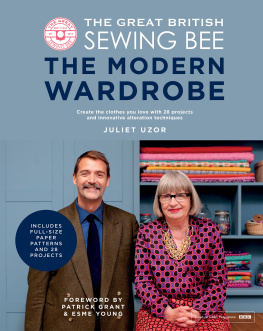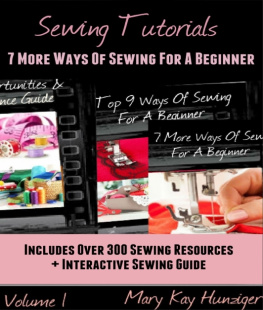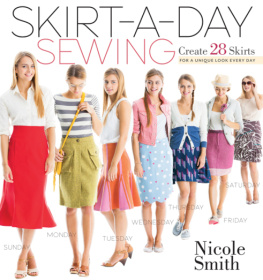THE NEW SEAMSTRESS
W omen come to the idea of making their own clothing for a variety of reasons. Some of us want clothes that fit better, some crave unusual things we cant find in shops, some want to make the luxurious items we cant afford to buy, some are intrigued by the technical aspects of the craft itself. But theres one thing Ive found most garment sewers have in common: an interest in clothes. I dont mean an interest in high fashion necessarily, but each budding seamstress has enough of a fascination with clothing to first pick up a needle and thread and say, I want to make that.
After all, a love of adornment is one of our most basic human tendencies. It exists in all cultures, telling stories about who we are and how we see ourselves. Clothing fills our desire for beauty, for change, for identity, for creativity and play. Not to mention, you interact with it constantly, bringing all those wonderful qualities of beauty and fun into your everyday life. What could be better?
But Ive found that there is a dark side to fashion. While it can be an amazing creative outlet, it can also fuel an almost endless desire to consume, to buy more things and to buy them less thoughtfully. With the advent of fast fashion in recent years, this is only getting worse, as stores turn over stock and bring in new fashion every few weeks rather than months. Advertisements inundate us with the message that we need newer, trendier items, and more of them. Soon, were not sure what our own taste is anymore, or how much we really want to own. We have closets of stuff and nothing to wear. Worse, our clothes feel like commodities, with no relationship to who we are.
For me, sewing has been an antidote to this rushing whirlwind of fashion and consumerism. It reclaims fashion as an opportunity for creativity, joy and self-expression. Its taught me about quality, and why Im drawn to some things and not others. Its given me a more thoughtful approach to my wardrobe, to my own tastes and even my own body. It lets me have fun with clothing, but do it on my own terms.
They say that acquiring more things will never make you happy, but that acquiring experiences can. Being able to make your own wardrobe, to dress exactly the way you choose, and the constant learning that accompanies it is an experience like no other.
THE SEWING EXPERIENCE
I like to sew in the evenings. Since Im a pattern designer by trade, Im surrounded by sewing all day long in my studio as I work on new designs, make up samples or write about sewing for my website. Even so, there are few things I find more relaxing then packing up work for the day, making a cup of tea and working on some personal sewing projects before heading home for dinner. Its my favorite way to unwind.
One evening, I had a bit of hand sewing to do. Since I was planning a trip to Argentina, I thought it might be fun to download some Spanish lessons and try them out while I set to work with needle and thread. The first lesson began slowly, covering basic words and greetings that were familiar to me, but also explaining some of the nuances of pronunciation and culture. The pace was relaxed, but it gave me an opportunity to learn some subtleties of the language. In short, they were excellent.
The Spanish instructor mentioned that the lessons were gradual for a reason, so that you should feel relaxed while doing them. He pointed out that a relaxed state is truly the best way to learn a language.
This same wisdom applies to sewing. Learning to sew clothing and learning a new language are both complex skills that take time to develop. They also both involve slowly building up from a foundation of very simple, basic ideas. It is those basic ideas that take you the farthest, because they are the ones you use every day as you build your skills. They are the ones you return to, even when your skill set becomes more advanced.
Just as there are many ways to learn a language, there are also many ways to learn to sew. In this book, Id like to help you build up and reinforce that foundation of skills. My goal is simple: that you feel good about what youre making and love the experience of sewing.
THE CURIOUS SEAMSTRESS
The Colette Sewing Handbook is intended as a resource for any adventurous, beginning sewer who wants to branch out, as well as intermediate sewers whod like to brush up their skills with a new, more thoughtful approach.
Theres only one trait I think every sewer should possess: curiosity. Learning to sew is an ongoing process; in fact, the learning never really stops. Each project has the potential to teach you something new. Even seamstresses who have been sewing for thirty years or more will tell you that they learn new things all the time. Let your curiosity guide you, and this will be a source of wonder rather than discouragement. A curious person who likes to learn will never get bored with sewing!
Of course, there are other characteristics that are helpful to a sewer. You dont need to be a naturally patient person, although Im sure it helps. I wouldnt know, Im highly impulsive and impatient by nature. When I get an idea in my head, I want it done now. But sewing has actually taught me patience, how to slow down and do things the right way, and that its much easier (and more rewarding) to learn to do something right than to fix a mistake over and over. Let your curiosity battle your impatience. Instead of asking How can I get this done faster?, ask How can I learn to do this better?
Attention to detail is another helpful characteristic to have, and one that can be learned. The more you sew, and the more you think about clothing, the more you will notice. Soon the details will become part of your sewing vocabulary.
THE FIVE FUNDAMENTALS
I take a holistic approach to sewing based on what I consider the five ingredients for a remarkable sewing experience: Forming a plan, using a pattern, choosing fabric, customizing the fit and finishing your garment well. While most sewing books focus purely on techniques, these essentials often get overlooked, especially in the beginning of a sewing education. You may learn to sew a dart, but you dont learn why darts are so important to the fit of your garment. In other words, Id like to tell you a bit about the why, not just the how. That way, youll be better equipped to keep asking questions, to keep learning, and to teach yourself as you go.
There are many books that cover a wide range of sewing techniques, and there are books that focus on a specific technical aspect of sewing. These are both useful types of books to have in your sewing library, and youll find several of them in the Recommended Reading section (page 156) at the end of this book.
But this book is a little different. We are going to look at the real fundamentals, the actual factors that make a sewing project feel successful and satisfying. Each chapter will cover a different principle, followed by a sewing project that will give you the opportunity to try out your skills. Even if you decide not to make all of the projects in the book, I highly recommend finishing up each chapter with a sewing project that will allow you to try your new skills. Combining these fundamentals with hands-on learning will give you an incredible boost and much more confidence.

